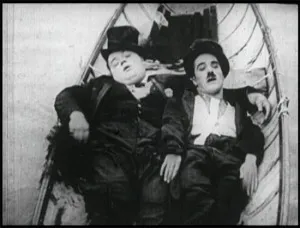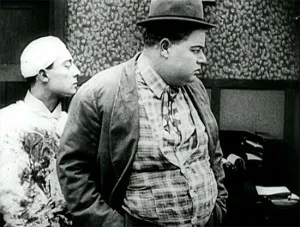More on Fatty Arbuckle: His Films and His Legacy
Notorious for a career-ending scandal, the comedian deserves to be remembered for his work in movies
/https://tf-cmsv2-smithsonianmag-media.s3.amazonaws.com/filer/20111116015020Good_Night_thumb1.jpg)
A recent posting on Smithsonian‘s history blog Past Imperfect, The Skinny on the Fatty Arbuckle Trial, discusses at length the murder case that helped ruin the comedian’s career. Since his films disappeared from the screen in the 1920s, Arbuckle (who personally disliked the nickname “Fatty,” preferring his given name Roscoe) has become a sort of shorthand for movie scandals. When news shows trot out montages of Hollywood sex scandals, his photo is invariably included. By neglecting to mention that the actor was exonerated, This Film Is Not Yet Rated, a 2006 documentary about the film ratings system, implies that Arbuckle was guilty of manslaughter in the death of actress Virginia Rappe.
Lost in the lurid hoopla is an understanding of Arbuckle’s standing in the history of cinema. He is one of the key figures in film comedy, as important in some ways as pioneers like Mack Sennett, who hired him to work at his Keystone studio in 1913. Arbuckle was on stage by the age of eight, and spent a decade touring the country as an actor and dancer. It was the kind of training the great screen clowns like Charlie Chaplin and Buster Keaton received. The experience taught Arbuckle how to play any kind of scene or situation, from rube to aristocrat, rural to urban, slapstick to melodrama. He knew what made a joke work, what endeared characters to theatergoers, and how far he could push a gag. Like the best screen comedians, Arbuckle knew how to make anyone laugh in a manner so effortless that it seems magical.

At Keystone, Sennett at first employed Arbuckle as a fat man, the butt of jokes. He didn’t originate the type on screen—the corpulent John Bunny, the first well-known film comedian, had made a string of successful movies at Vitagraph. Indeed, it’s a stereotype that appears throughout culture: think of the Greek god Bacchus, or Shakespeare’s Falstaff.
Arbuckle flourished on screen, starring in a wide gamut of films that appeared almost weekly. He built a stock company of actors and technicians, began overseeing his scripts, and eventually became a director. He teamed with Mabel Normand in a series of domestic comedies that set a template for today’s television sitcoms, and held his own with comic stars like Charlie Chaplin. At the same time, he helped develop a new type of screen comedy, one based more on psychology than pratfalls, one that could examine the motives and feelings of its characters instead of just hurling them into slapstick chases.
Perhaps because of his dance training, Arbuckle was an uncommonly graceful performer, adept at comic falls but also at sleight of hand. He loved working with props, juggling everything from frying pans to vases, and he loved stretching out routines. Good Night, Nurse, for example, opens with a three-minute scene in which he tries to light a cigarette in the driving rain.

Arbuckle was also a fearless performer who would try anything for a laugh. He could be casually subversive, employing ghoulish black comedy in Good Night, Nurse, with its hints of dismemberment and murder at a sanitarium. He frequently dressed in drag, enjoyed the kind of violent jokes that would become standard in cartoons, and could be casually contemptuous of the status quo. On screen he was a man of enormous appetites—immature, irreverent, disdainful of authority and obsessed with sex in a weirdly adolescent way.
Just as important as his performing style, Arbuckle worked out new ways to film comedy. He used unusual angles to emphasize jokes, experimented with point of view to involve viewers more closely with characters, and found new ways to exploit technology. Watch how the camera slowly goes out of focus when his character is sedated in Good Night, Nurse. Or how carefully he frames his jokes in The Garage.
Like Chaplin, Arbuckle outgrew Keystone. He moved to New York, where producer Joseph Schenck established the Comique Film Corporation for him. In 1917, Arbuckle met Buster Keaton, at the time a vaudeville star, and convinced him to try movies. The fourteen subsequent films they made together document one of the best comic teams ever captured on film. Arbuckle taught Keaton the fundamentals of cinema, while Keaton helped hone his mentor’s comic skills. In 1920, Arbuckle signed a contract with Paramount, the first comedian to make the switch from shorts to feature films.
His screen persona worked against him when he was arrested after Rappe’s death. Stirred up by sensational newspaper accounts of debauchery, Americans were perfectly willing to believe that Arbuckle was guilty. When the truth became apparent, it was too late to save his career. Fortunately, many of his films survive. They rank with the best of the silent comedies. Ironically, it is their sense of innocence and wonder that distinguishes them from the more calculating slapstick shorts of the period. Fatty and Mabel Adrift, for example, displays a sunny, rural surrealism that has no real equivalent in films of the time.
Consciously or not, Arbuckle’s influence continues to be felt on screen and television. Keaton reworked many of the gags from the films he made with Arbuckle in his own series of shorts and features. Arbuckle’s nephew Al St. John had a long screen career. Hollywood loves the stereotype Arbuckle inhabited: from Oliver Hardy down through Sydney Greenstreet, Laird Cregar and Peter Ustinov. In recent years John Belushi, John Candy and Chris Farley met untimely ends; John Goodman, George Wendt, Kevin Smith and others follow in the screen tradition established by John Bunny and Roscoe Arbuckle.
/https://tf-cmsv2-smithsonianmag-media.s3.amazonaws.com/accounts/headshot/daniel-eagan-240.jpg)
/https://tf-cmsv2-smithsonianmag-media.s3.amazonaws.com/accounts/headshot/daniel-eagan-240.jpg)